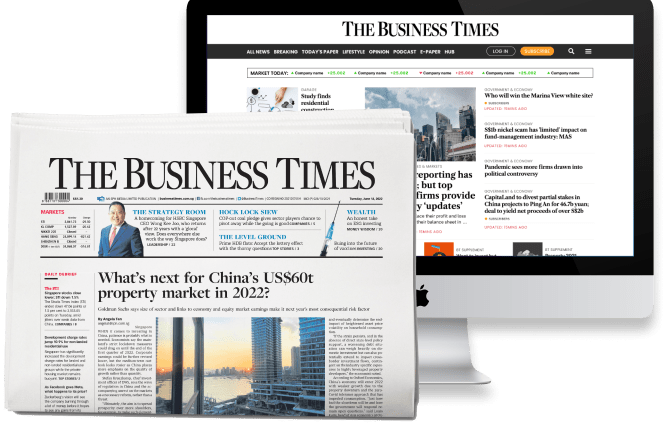With liftoff done, the Fed revisits a US$4.5 trillion quandary
[WASHINGTON] Federal Reserve officials who spent months debating their first interest-rate increase in almost a decade are turning next to the thorny question of what to do with a balance sheet equivalent to the size of Japan's economy.
A month after liftoff, turmoil in global financial markets has pushed out expectations for more rate hikes and raised concern about what tools are available to fight the next downturn. Vice Chairman Stanley Fischerhas suggested the US$4.5 trillion balance sheet could be maintained as a way to hold down longer-term Treasury yields while the short-term policy rate was lifted.
Mr Fischer's idea - discussed in a Jan 3 speech partly on strategies for pulling the short-term rate away from zero - was taken up in more practical terms by New York Fed President William Dudley Friday. Reinvesting maturing bonds and putting off a reduction in the balance sheet until the federal funds rate is raised somewhat higher "makes sense," Mr Dudley said.
"Having more 'dry powder' in the form of higher short-term interest rates seems more desirable than less dry powder and a smaller balance sheet," he said.
Fed Chair Janet Yellen made similar comments in her Dec 16 press conference, meaning the three most senior officials still view the central bank's vast holdings of debt as an active policy tool rather than a relic of the financial crisis that needs to be shrunk as soon as possible.
"Dudley's view is if we get to choose our tool" to tighten policy, "then we are going to choose interest rates," said Michael Hanson, senior economist at Bank of America Corp. That's the safer choice, Hanson said, because officials are highly uncertain what shrinking the balance sheet would do to financial markets.
The preference to maintain trillions in bond holdings for months to come, however, isn't likely to be popular with all Federal Open Market Committee participants. Richmond Fed President Jeffrey Lacker favors an "expeditious" unwinding of the Fed's bond holdings.
The Fed's balance sheet swelled to US$4.5 trillion in 2014 from about US$900 billion in 2008 on purchases of Treasuries and mortgage-backed securities, during three stages of a strategy known as quantitative easing.
The Fed keeps its assets at that level by reinvesting the proceeds of maturing debt, a tactic it pledged to end when rate hikes are "well under way." Some private economists define that as a federal funds rate, currently in a range of 0.25 per cent to 0.5 per cent, of at least 1 per cent, and probably higher. Mr Dudley said there shouldn't be a "numerical tripwire" for ending the program, and economic conditions should shape the decision.
"The risk is that this period of financial volatility is sustained and results in actual slowing of economic activity that brings rate hikes down to two this year," said Robert Martin, US economist at Barclays Capital Inc. in New York, which expects the Fed to begin shrinking the balance sheet in March 2017. "That will start pushing balance-sheet normalization out" to a later date, he said.
"Well under way' doesn't mean one or two rate hikes," said Lou Crandall, chief economist at Wrightson ICAP LLC in Jersey City, New Jersey. "The expected trajectory of rate hikes has gotten flatter and that means 2017, not 2016" for allowing run- off to begin, he said.
The timing of the Fed's expected tightening is getting pushed back in part because the economy appeared to lose momentum heading into this year. Barclays Plc lowered its fourth-quarter GDP forecast to 0.3 per cent growth at an annual pace from a 0.7 per cent rate, while Credit Suisse Group AG cut to 0.8 per cent from 1 per cent. In the third quarter, the economy expanded 2 per cent.
With more than US$1 trillion in Treasury debt maturing over the next four years, according to data compiled by Bloomberg, the decision to shrink the portfolio is as important as last month's increase in the benchmark rate, and the debate may be even more contentious.
For now, the committee is in no hurry, with many members considering the balance sheet a still useful tool of stimulus. Keeping it high while the short-term rate creeps higher is consistent with the committee's outlook for "gradual" rate increases.
In their September 2014 exit strategy principles, the Fed left the answers about what's next for the balance sheet open to interpretation. They called for holding "no more securities than necessary to implement monetary policy efficiently." JPMorgan Chase & Co Chief US Economist Michael Feroli said he isn't convinced the 2014 statement is the final say on the matter. Just what they mean by "efficiently" is "the most tangible aspect of the debate," he said.
Meanwhile, raising short-term rates while leaning against long-term rates by maintaining holdings of Treasuries and mortgage-backed securities carries some parallels to Operation Twist - a strategy the Fed used in 2011 to flatten the yield curve.
"The crucial question is whether the Fed should be using quantitative measures like Operation Twist during normal times," said Andrew Levin, an economics professor at Dartmouth College in Hanover, New Hampshire, and a former policy adviser to Ms Yellen when she was the Fed vice chair.
"It's hard to answer that question without having a clear understanding of how quantitative easing works or how effective it is."
BLOOMBERG
BT is now on Telegram!
For daily updates on weekdays and specially selected content for the weekend. Subscribe to t.me/BizTimes
International
Xi tells Blinken US, China should be 'partners, not rivals'
Indonesia’s push for regional economic integration to continue under Prabowo: Vivian Balakrishnan
Outgoing Singapore, Indonesia leaders to hold their final retreat in Bogor on Apr 29
Beijing city to subsidise domestic AI chips, targets self-reliance by 2027
China passes tariff law as tensions with trading partners simmer
Blinken meets Chinese counterpart Wang Yi in Beijing
